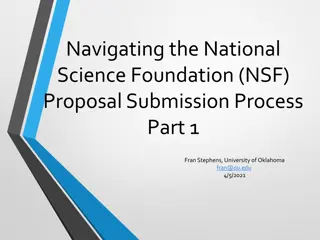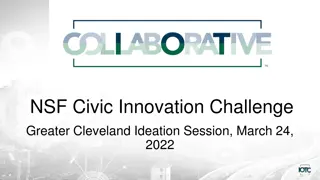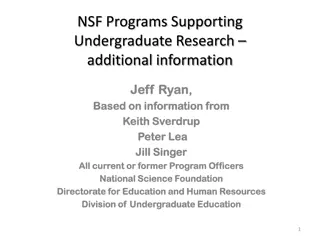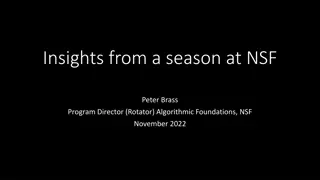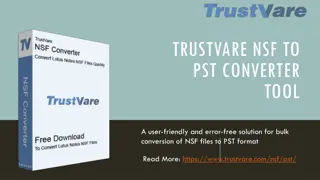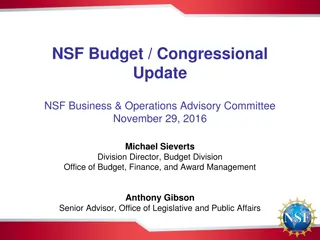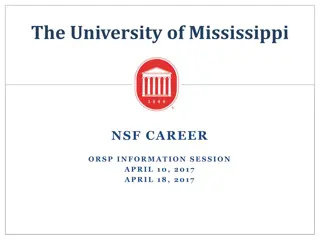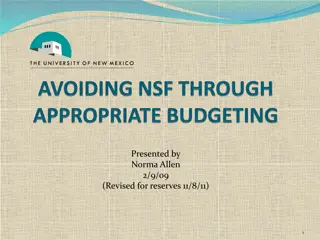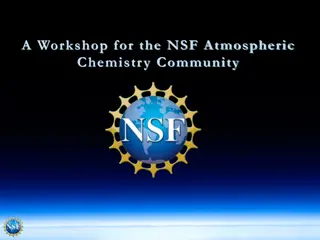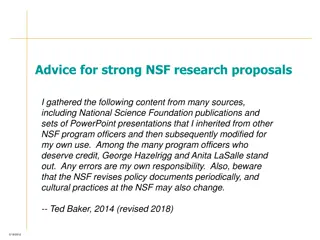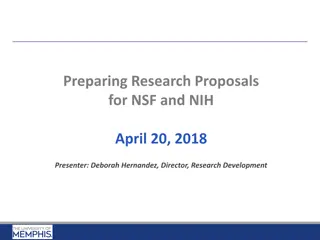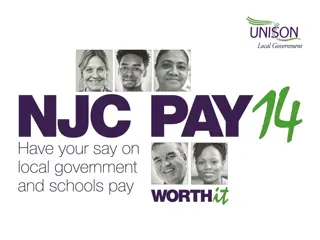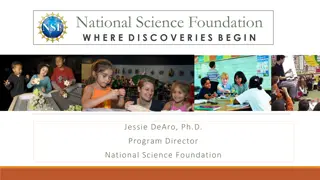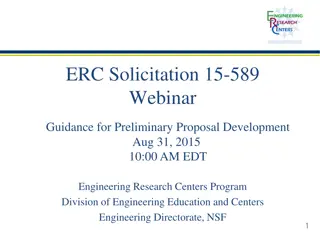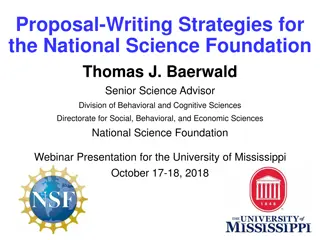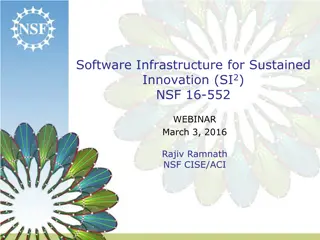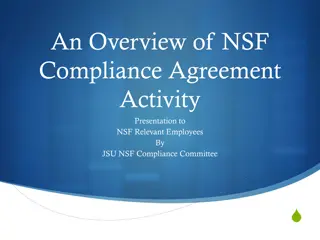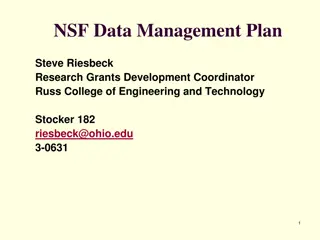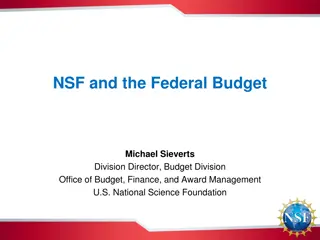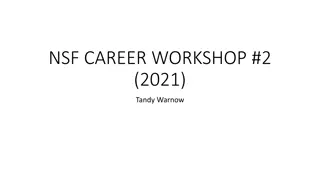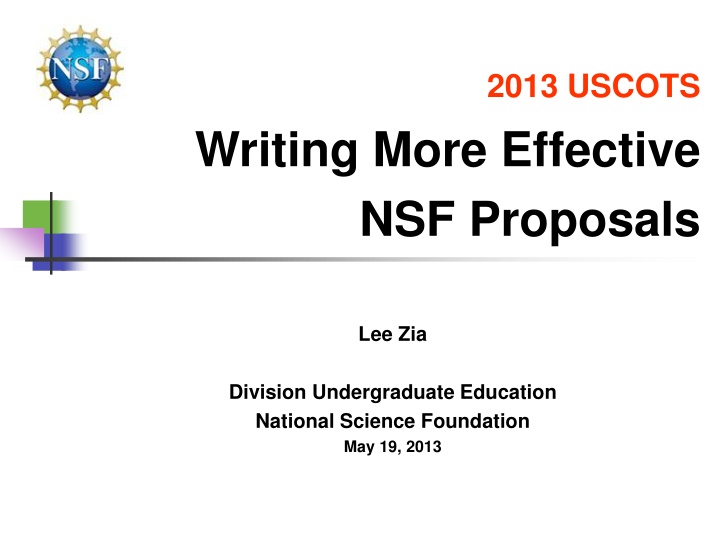
Crafting Effective NSF Proposals: Insider Tips and Strategies
Enhance your NSF proposal writing skills with expert advice and valuable insights from this comprehensive guide. Learn to address key criteria, draft impactful proposals, and avoid common pitfalls for a successful submission to the National Science Foundation.
Download Presentation

Please find below an Image/Link to download the presentation.
The content on the website is provided AS IS for your information and personal use only. It may not be sold, licensed, or shared on other websites without obtaining consent from the author. If you encounter any issues during the download, it is possible that the publisher has removed the file from their server.
You are allowed to download the files provided on this website for personal or commercial use, subject to the condition that they are used lawfully. All files are the property of their respective owners.
The content on the website is provided AS IS for your information and personal use only. It may not be sold, licensed, or shared on other websites without obtaining consent from the author.
E N D
Presentation Transcript
2013 USCOTS Writing More Effective NSF Proposals Lee Zia Division Undergraduate Education National Science Foundation May 19, 2013
Outline General advice NSF context and criteria Mock Panel Review Helpful Hints/Fatal Flaws Conclusion 3
Great Idea to Great Proposal Great Idea to Great Proposal Addresses a recognized problem, need or opportunity: innovative within its context Proposed intervention has the potential for important and widespread impacts Problem, need or opportunity and possible solutions are well researched and referenced Clearly articulated goals and objectives Proposal answers: Who, What, Where, When, Why, and How? 4
Basic Proposal Parts Basic Proposal Parts (but be sure to read the solicitation!) Project Summary (Intellectual Merit and Broader Impacts) Project Description Goals and outcomes Background and rationale Implementation and management plan Qualifications of personnel, availability of resources Evaluation Plan Dissemination Plan References, Biosketches of the PI team, other information Budget and Budget Justification Current and Pending Support 5
Proposal review criteria Proposal review criteria and review process and review process Two criteria for peer review Intellectual Merit (IM) Broader Impacts (BI) 6
NEW! Merit Review Criteria Guiding Principles All NSF projects should be of the highest quality and have the potential to advance, if not transform, the frontiers of knowledge. NSF projects, in the aggregate, should contribute more broadly to achieving societal goals. Meaningful assessment and evaluation of NSF funded projects should be based on appropriate metrics, keeping in mind the likely correlation between the effect of broader impacts and the resources provided to implement projects. 7
(NEW!) Merit Review Criteria Intellectual Merit: The intellectual Merit criterion encompasses the potential to advance knowledge; and Broader Impacts: The Broader Impacts criterion encompasses the potential to benefit society and contribute to the achievement of specific, desired societal outcomes. 8
NEW! Merit Review Elements The following elements should be considered in the review for both criteria: What is the potential for the proposed activity to: advance knowledge and understanding within its own field or across different fields (Intellectual Merit); and benefit society or advance desired societal outcomes (Broader Impacts)? To what extent do the proposed activities suggest and explore creative, original, or potentially transformative concepts? Is the plan for carrying out the proposed activities well-reasoned, well- organized, and based on a sound rationale? Does the plan incorporate a mechanism to assess success? How well qualified is the individual, team, or institution to conduct the proposed activities? Are there adequate resources available to the PI (either at the home institution or through collaborations) to carry out the proposed activities? 1. a) b) 2. 3. 4. 5. 9
Intellectual Merit Addresses a major challenge Improved student learning Informed by other projects Effective evaluation and dissemination Led by capable faculty and others Adequate facilities and resources Institutional and departmental commitment 10
Broader Impacts Integrated into the institution s academic programs Contributes to knowledge base and useful to other institutions Widely used products which can be disseminated through commercial and other channels Improved content and pedagogy for faculty Increased participation by women, underrepresented minorities, and persons with disabilities Ensures high quality STEM education for people pursuing careers in STEM fields or as teachers or technicians 13
NSF Proposal Review and Decision Process Mail Reviews Award (Via DGA) FastLane: Central Processing Declination Division Director Program Manager Investigator/ Institution Withdrawal Inap- propriate Panel Review 16
Practical Aspects of the Review Process Reviewers read, review, and rate 10- 12 proposals before the review panel Reviewers have a finite time during the panel for the discussion of your proposal Reviewers bring a mix of reviewing experience to the panel 17
Mock Panel Review Mock Panel Review san060417 25565 18
What do What do YOU YOU think? think? Write down three strengths commonly cited by reviewers. Share with a neighbor or two. 21
Most Common Strengths Most Common Strengths Cited by Reviewers Cited by Reviewers Strengths Cited in More Than 20 % of the Panel Summaries Evaluation plan Work these into your proposal, but only if meaningful Build on prior work or products Large impact Dissemination, contribution to KB Potential for involving W&M Collaboration details PI's strong Important, timely, or responsive 0 10 20 30 40 50 60 Percent 22
What do What do YOU YOU think? think? Write down three weaknesses commonly cited by reviewers. Share with a neighbor or two. 23
Most Common Weaknesses Most Common Weaknesses Cited by Reviewers Cited by Reviewers Weaknesses Cited in More Than 20 % of the Panel Summaries Too many proposals lose funding because of inadequate evaluation and dissemination plans. Don t let your proposal be one of them! Collaboration details Large impact Innovative or novel Build on prior work or products Potential for involving W&M Dissemination & contribution to KB Activities doable & related to outcomes Evaluation plan Sufficient detail and clear plans 0 10 20 30 40 50 60 Percent 24
Compliance Check To be compliant all DUE proposals must have the following: Intellectual Merit and Broader Impact must be inputted separately in the project summary The project description cannot be more than 15 pages Proposals that include support for a postdoctoral researcher must include a mentoring plan Correct font size Arial, Courier New, or Palatino Linotype at a font size of 10 points or larger Times New Roman at a font size of 11 points or larger Computer Modern family of fonts at a font size of 11 points or larger 25
Helpful Hints/ Fatal Flaws 26
Bye for Now. Hope to Hear From You Soon. NSF needs all of you. You may need NSF!!
Questions? Contact Us! Ron Buckmire, rbuckmir@nsf.gov Mike Jacobson, mjacobso@nsf.gov Lee Zia, lzia@nsf.gov Phone: 703-292-8670 28

